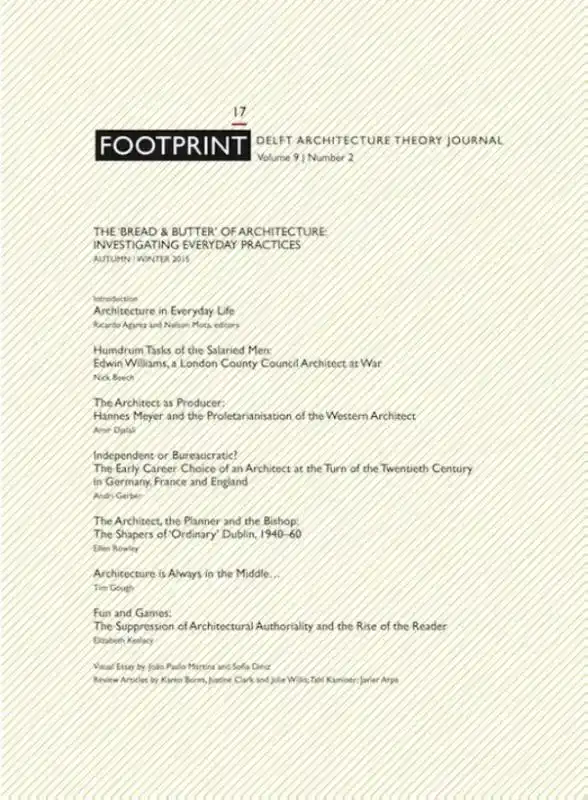- Engels
- Pockets
- kunst algemeen
- bouwkunst, archit.
- FOOTPRINT 17
ONBEKEND \ MERKLOOS
FOOTPRINT 17
25,00incl BTW
Vertrouwd sinds 1927
Persoonlijke aandacht en advies
Vanaf 17,50 gratis verzenden NL & BE
Meer dan 150.000 artikelen online
Omschrijving FOOTPRINT 17
The canon of western contemporary architecture has overlooked everyday, ''salaried'' architecture - overwhelming as it may have turned out to be in our built environment - praising instead the solo designer and his ground-breaking work.
Sin
ce World War I, the social role of the architect (in terms both of his or her place in social hierarchies and of his or her contribution for social betterment) seems to have been primarily tested, and largely consolidated, in ''departmental architect
ure''. Yet the work of county, city and ministerial architects, heads of department in welfare commissions, guilds and cooperatives, is seldom discussed as such: its specificity as the product of institutional initiatives and agents, as the outcome o
f negotiation between individual and collective agendas, remains little explored, even when authors celebrate the many public-designed projects that are part of the canon. On the other hand, commercially driven architecture and the business side of t
he profession are still anathema for many, despite being essential factors in the discipline''s position in society.
Footprint 17 addresses the architectural production of those who played their part in inconspicuous offices and unexciting d
epartments, and that contribute insights to discuss the place of the architecture of ''bread & butter'' in architectural history studies and in the politics of architectural design and theory.
This issue of Footprint explores intellectual framew
orks, didactic practices, research methods and analytical instruments that project the disciplinary focus further than the work of the ''prime mover'', discussing the relevance of ''salaried'' architects and institutional agency in shaping the spatia
l and social practices of the everyday.
Footprint is an academic journal dedicated to publishing architecture and urban research. Architecture and urbanism are the points of departure and the core interests of the journal. From this perspec
tive, the journal encourages the study of architecture and the urban environment as a means of comprehending culture and society, and as a tool for relating them to shifting ideological doctrines and philosophical ideas. The journal promotes the crea
tion and development - or revision - of conceptual frameworks and methods of inquiry. It is engaged in creating a body of critical and reflexive texts with a breadth and depth of thought which would enrich the architecture discipline and produce new
knowledge, conceptual methodologies and original understandings.
Sin
ce World War I, the social role of the architect (in terms both of his or her place in social hierarchies and of his or her contribution for social betterment) seems to have been primarily tested, and largely consolidated, in ''departmental architect
ure''. Yet the work of county, city and ministerial architects, heads of department in welfare commissions, guilds and cooperatives, is seldom discussed as such: its specificity as the product of institutional initiatives and agents, as the outcome o
f negotiation between individual and collective agendas, remains little explored, even when authors celebrate the many public-designed projects that are part of the canon. On the other hand, commercially driven architecture and the business side of t
he profession are still anathema for many, despite being essential factors in the discipline''s position in society.
Footprint 17 addresses the architectural production of those who played their part in inconspicuous offices and unexciting d
epartments, and that contribute insights to discuss the place of the architecture of ''bread & butter'' in architectural history studies and in the politics of architectural design and theory.
This issue of Footprint explores intellectual framew
orks, didactic practices, research methods and analytical instruments that project the disciplinary focus further than the work of the ''prime mover'', discussing the relevance of ''salaried'' architects and institutional agency in shaping the spatia
l and social practices of the everyday.
Footprint is an academic journal dedicated to publishing architecture and urban research. Architecture and urbanism are the points of departure and the core interests of the journal. From this perspec
tive, the journal encourages the study of architecture and the urban environment as a means of comprehending culture and society, and as a tool for relating them to shifting ideological doctrines and philosophical ideas. The journal promotes the crea
tion and development - or revision - of conceptual frameworks and methods of inquiry. It is engaged in creating a body of critical and reflexive texts with a breadth and depth of thought which would enrich the architecture discipline and produce new
knowledge, conceptual methodologies and original understandings.
Specificaties
- MerkONBEKEND \ MERKLOOS
- GroepKUNST ALGEMEEN (640)
- Barcode9789490322618
- LeverstatusActief
Reviews
0.0/5.0
Gemiddelde uit 0 reviews
Meest behulpzame reviews
Nog geen reviews geschreven


